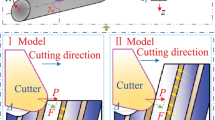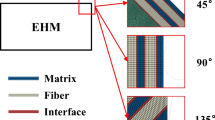Abstract
Carbon fiber–reinforced plastic (CFRP) is increasingly employed as structural components for aircrafts in aerospace. The plain-woven CFRP is more commonly used than the UD-CFRP. The machining-induced damages are easy to occur. The influence of the plain-woven structure on the cutting mechanism and the defects occurrence mechanism are seldom studied in detail. In this paper, the three-dimensional FEM model of plain-woven CFRP is established. The occurrence and propagation of the delamination are investigated. The results indicate that the stress concentrations are easy to occur at the junction of warp and fill bundles near the cutting position. The plain-woven structure can block the transfer of stress and the crack propagation. When θ = 90°, the damages of the fill fibers and the crack of the interface are easy to occur. When θ = 45°, the step-like fracture is formed in both of the warp and the fill bundles, especially in the fill bundles. Under the same cutting conditions, the exit delamination of the plain-woven CFRP is obviously less than that of the UD-CFRP. The delamination greatly increases with the increase of the feed speed. The delamination decreases with the increase of the cutting speed. The delamination is closely related to the instantaneous cutting position of the cutter.










Similar content being viewed by others
Data availability
All data generated or analyzed during this study are included in this published article.
Abbreviations
- oxy :
-
Coordinate system of bundle
- P 1 :
-
Amplitude of the bending curve in y direction (P1 = a/2)
- a :
-
Hickness of the bundle cross-section center
- b :
-
Distance between two adjacent warp bundles
- P 3 :
-
Offset distance of the bending curve in y direction
- d :
-
Thickness of cross-section edge
- E f :
-
Young’s elastic modulus of the fiber
- E m :
-
Young’s elastic modulus of the matrix
- c f :
-
Fiber volume fraction
- c m :
-
Matrix volume fraction
- G f :
-
Fiber shear modulus
- G m :
-
Matrix shear modulus
- ν f :
-
Fiber Poisson’s ratio
- ν m :
-
Matrix Poisson’s ratio
- E 1 :
-
Equivalent elastic modulus in 1-direction (viz., the fiber axial direction)
- E 2 :
-
Equivalent elastic modulus in 2-direction (viz., vertical the fiber axial direction)
- G 12 :
-
In-plane shear modulus
- ν 12 :
-
Equivalent Poisson’s ratio for the deformation in 2-direction causing by the stress in 1-direction
- ν 21 :
-
Equivalent Poisson’s ratio for the deformation in 1-direction causing by the stress in 2-direction
- θ :
-
Warp fiber orientation
- X t :
-
Ultimate tensile strength
- X c :
-
Ultimate compressive strength
References
Choudhury MR, Srinivas MS, Debnath K (2018) Experimental investigations on drilling of lignocellulosic fiber reinforced composite laminates. J Manuf Process 34:51–61
Zhu Z, Guo K, Sun J, Li J, Liu Y, Zheng Y, Chen L (2018) Evaluation of novel tool geometries in dry drilling aluminium 2024–T351/titanium Ti6Al4V stack. J Mater Process Tech 259:270–281
Wang X, Shen X, Zeng C, Sun F (2018) Combined influences of tool shape and as-deposited diamond film on cutting performance of drills for CFRP machining. Surf Coat Tech 347:390–397
Loja MAR, Alves MSF, Bragança IMF, Rosa RSB, Barbosa ICJ, Barbosa JI (2018) An assessment of thermally influenced and delamination-induced regions by composites drilling. Compos Struct 202:413–423
Xu J, Li C, Mi S, An Q, Chen M (2018) Study of drilling-induced defects for CFRP composites using new criteria. Compos Struct 201:1076–1087
Deng H, Xu Z (2019) Dressing methods of superabrasive grinding wheels: a review. J Manuf Process 45:46–69
Alessandro A, Khamis E (2019) 3D micro-mechanical modelling of orthogonal cutting of UD-CFRP using smoothed particle hydrodynamics and finite element methods. Compos Struct 218:174–193
Alessandro A, Sein LS, Khamis E (2017) Modelling the orthogonal cutting of UN-CFRP composites: development of a novel cohesive zone model. Compos Struct 168:65–83
Su YL (2019) Effect of the cutting speed on the cutting mechanism in machining CFRP. Compos Struct 220:662–676
Meng Q, Cai J, Cheng H, Zhang K (2020) Investigation of CFRP cutting mechanism variation and the induced effects on cutting response and damage distribution. Int J Adv Manuf Technol 106:2893–2907
Cepero-mejias F, Curiel-sosa JL, Zhang C, Phadnis VA (2019) Effect of cutter geometry on machining induced damage in orthogonal cutting of UD polymer composites: FE study. Compos Struct 214:439–450
Li HN, Wang JP, Wu CQ, Zhao YJ, Xu J, Liu XL, Zhu WQ (2020) Damage behaviors of unidirectional CFRP in orthogonal cutting: a comparison between single- and multiple-pass strategies. Compos part B 185:1–13
Liu HT, Lin J, Sun YZ, Zhang JY (2019) Micro model of carbon fiber/cyanate ester composites and analysis of machining damage mechanism. Chin J Mech Eng 32(52):1–11
Cheng H, Gao JY, Kafka OL, Zhang KF, Luo B, Liu WK (2017) A micro-scale cutting model for UD CFRP composites with thermo-mechanical coupling. Compos Sci Tech 153:18–31
Kisshore D, Inderdeep S (2017) Low-frequency modulation-assisted drilling of carbon-epoxy composite laminates. J Manuf Process 25:262–273
Voss R, Seeholzer L, Kuster F, Wegener K (2017) Influence of fiber orientation, tool geometry and process parameters on surface quality in milling of CFRP. CIRP J Manuf Sci Tech 18:75–91
Hintze W, Hartmann D, Schutte C (2011) Occurrence and propagation of delamination during the machining of carbon fiber reinforced plastics (CFRPs) – an experimental study. Compos Sci Tech 71:1719–1725
Hintze W, Brugmann F (2018) Influence of spatial tool inclination on delamination when milling CFRP. J Mater Process Tech 252:830–837
He YL, Qing HA, Zhang SG, Wang DZ, Zhu SW (2017) The cutting force and defect analysis in milling of carbon fiber-reinforced polymer (CFRP) composite. Int J Adv Manuf Tech 93:1829–1842
Hintze W, Cordes M, Koerkel G (2015) Influence of weave structure on delamination when milling CFRP. J Mater Process Tech 216:199–205
Li MJ, Huang MJ, Jiang XG, Kuo CL, Yang XJ (2018) Study on burr occurrence and surface integrity during slot milling of multidirectional and plain woven CFRPs. Int J Adv Manuf Tech 97:163–173
Wang DN, Li JL, Jiao YN (2013) 3D meso-geometrical model of plain weave fabric and finite element modeling under ballistic impact. J Mater Eng 9:69–78
Funding
This work was financially supported by the National Science Foundation of China (No. 52175400, No. 51805164, No. 52075127), Natural Science Foundation of Hunan Province (No. 2021JJ30263), and Natural Science Foundation of Jiangsu Province (No.BK20201474).
Author information
Authors and Affiliations
Contributions
Su Fei: conceptualization, formal analysis, resources, writing—review and editing, supervision, project administration, funding acquisition. Guojun Dong: modeling analysis, test operation, writing—review and editing (Sect. 4). Chunjie Li: methodology, validation, investigation, data curation, writing original draft. Zhen Lei: data curation, writing-review and editing (Sect. 2.3). Bing Chen: test operation, Matlab programming.
Corresponding author
Ethics declarations
Ethics approval
Authors have read the “Ethical Responsibilities of Authors” and “Compliance with Ethical Standards.” Results are presented clearly, honestly, and without fabrication, falsification, or inappropriate data manipulation. Complied fully with the COPE guidelines.
Consent to participate
Not applicable.
Consent for publication
Not applicable.
Competing interests
The authors declare no competing interests.
Additional information
Publisher's Note
Springer Nature remains neutral with regard to jurisdictional claims in published maps and institutional affiliations.
This is an original paper which has neither previously, nor simultaneously, in whole or in part been submitted anywhere else.
Rights and permissions
About this article
Cite this article
Dong, G., Su, F., Li, C. et al. Effect mechanism of plain-woven structure of carbon fiber on CFRP cutting. Int J Adv Manuf Technol 119, 3223–3234 (2022). https://doi.org/10.1007/s00170-021-08470-9
Received:
Accepted:
Published:
Issue Date:
DOI: https://doi.org/10.1007/s00170-021-08470-9




